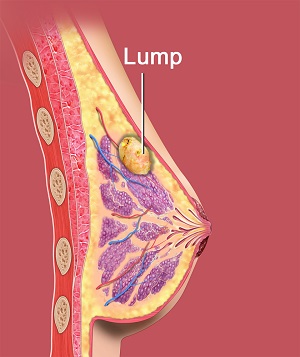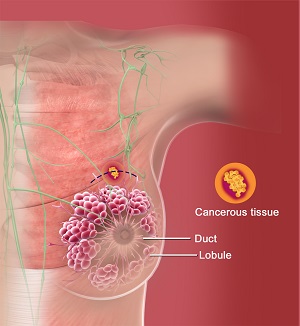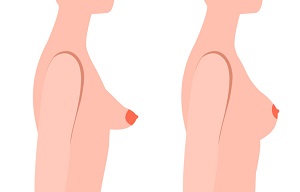- Breast Pain

Breast pain, also referred to as mastalgia, mastodynia, and mammalgia, is any discomfort, tenderness, or pain in the breast or underarm region. The pain may range from mild to severe and can affect women of any age, but is most common in perimenopausal and premenopausal women.
Know More - Breast Lump

A breast lump is a mass or growth of tissue that develops within the breast. It could occur as a bulge, protuberance, bump, or a localised swelling in the breast that feels and looks different from the surrounding breast tissue.
Know More - Breast Cyst

A breast cyst is a fluid-filled sac located in the breast tissue. They are mostly benign or non-cancerous and occur most commonly in women aged 35 to 50 years, although they can develop at any age.
Know More - Benign Breast Lumps

The majority of breast lumps are benign tumours that remain localised and do not spread to neighbouring tissues. They can be surgically removed and cause no harm to other organs of the body. An understanding of benign breast disorders is essential to help relieve unnecessary apprehensions.
Know More - Breast Cancer

A woman’s breasts are made of specialised tissues supplied by blood vessels, lymph nodes, and nerves. Breast cancer is the uncontrolled growth of cells in the breast. This mass of abnormal tissue is called a tumour. Breast cancer can develop in both men and women, although female breast cancer is more common.
Know More - Breast Cancer During Pregnancy

Surgery is the safest form of treatment for breast cancer during pregnancy. Chemotherapy may be administered after the first trimester (first 3 months of pregnancy). Other forms of treatment, such as radiation, targeted therapy, and hormone therapy, could harm your baby and are best administered after delivery.
Know More - Inflammatory Breast Cancer

Inflammatory breast cancer is a rare form of breast cancer in which the breast has a red and swollen appearance due to blockage of lymph vessels. This is an aggressive type of breast cancer that usually develops from the cells lining the milk ducts.
Know More - Triple Negative Breast Cancer

Triple negative breast cancer is a rare form of breast cancer that tests negative for oestrogen and progesterone receptors, as well as HER2 receptors.
Know More - Mastitis

Mastitis is inflammation of the breast tissue in your mammary glands often caused by blocked milk ducts but sometimes involves an infection. The condition most commonly affects women who are breastfeeding (lactating women).
Know More - Breast Disorders

Breast disorders can be defined as medical conditions or problems concerning the breasts that can negatively affect their structure or functioning.
Know More - Gynaecomastia

Gynaecomastia is a medical condition in which boys' and men's breasts expand and become abnormally large in size. It can affect one or both breasts and is commonly noted in teenage boys and older men.
Know More - Inverted Nipples

Inverted nipples, also known as retracted nipples, is a medical condition in which one or both nipples turn inward or lie flat against the areola (the darker circular area of skin around the nipple), instead of pointing outward or sticking out.
Know More - Fibroadenoma

Fibroadenoma is a benign or noncancerous breast tumour that mostly occurs as a small, solid lump in the breast tissue measuring about 1 to 2 centimetres in size.
Know More - Breast Abscesses

A breast abscess can be defined as a localised, painful pus-filled lump that develops beneath the skin of the breast. It most commonly occurs in women who are breastfeeding, but can also affect non-breastfeeding women aged 15 to 45 years.
Know More - Duct Ectasia

Duct ectasia, or mammary duct ectasia, is a benign or noncancerous breast condition in which one or more milk ducts (tubes that transfer milk to the nipple) become swollen and blocked. This can cause a build-up that leads to an infectious condition called periductal mastitis.
Know More - Phyllodes Tumour

Phyllodes tumour is a rare breast tumour that grows in the connective tissues (stroma) and ligaments that surround the blood vessels, lymph vessels, and ducts of the breast. The name Phyllodes is derived from the Greek language, which literally means “leaflike,” referring to the fact that the tumour cells develop in a leaf-like pattern.
Know More - Breast Nipple Changes

Unusual changes in your nipple shape, colour or secretions are known as breast nipple changes. There are numerous reasons associated with nipple changes. It is necessary to understand and diagnose nipple changes associated with cancer or infection or any other disorder.
Know More - Breast Shape Changes

A change in breast shape does not always mean you have cancer, but any change in the appearance or feel of your breasts should always be investigated by a doctor.
Know More - Atypical Changes in the Breast Tissue

An accumulation of abnormal cells in the breast is referred to as atypical changes in the breast tissue.
Know More - Breast Augmentation

Breast augmentation, also known as augmentation mammoplasty, is a surgical procedure designed to enhance the size and shape of the breasts by inserting implants.
Know More
